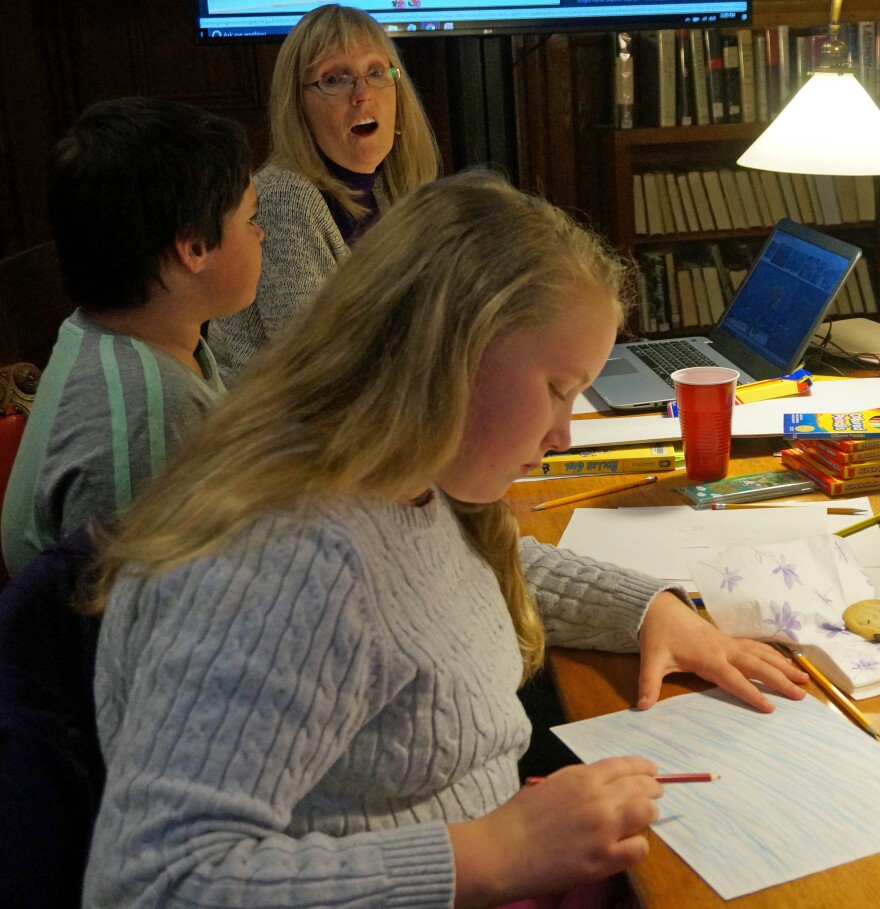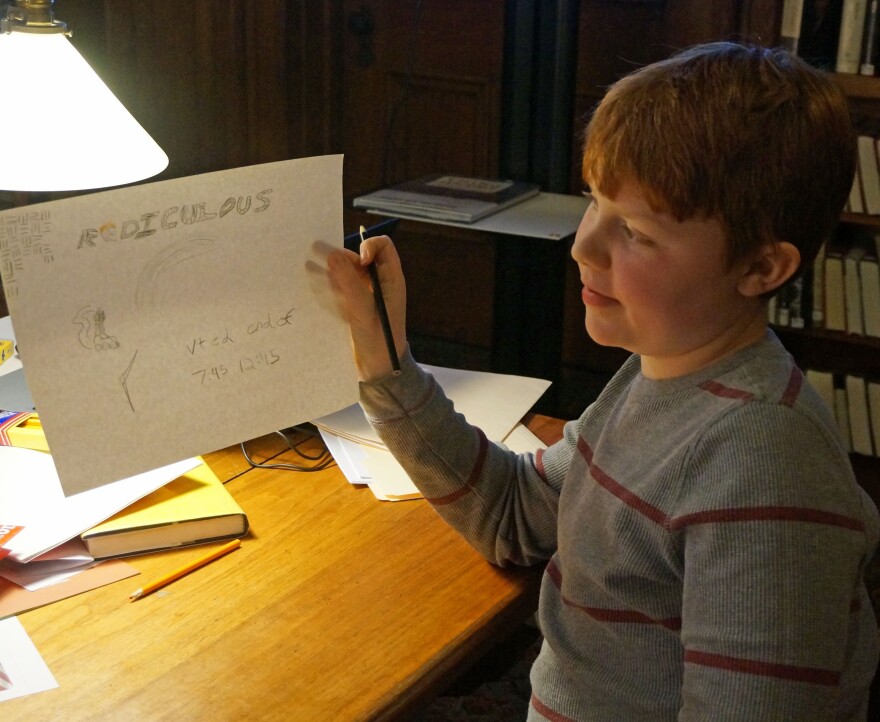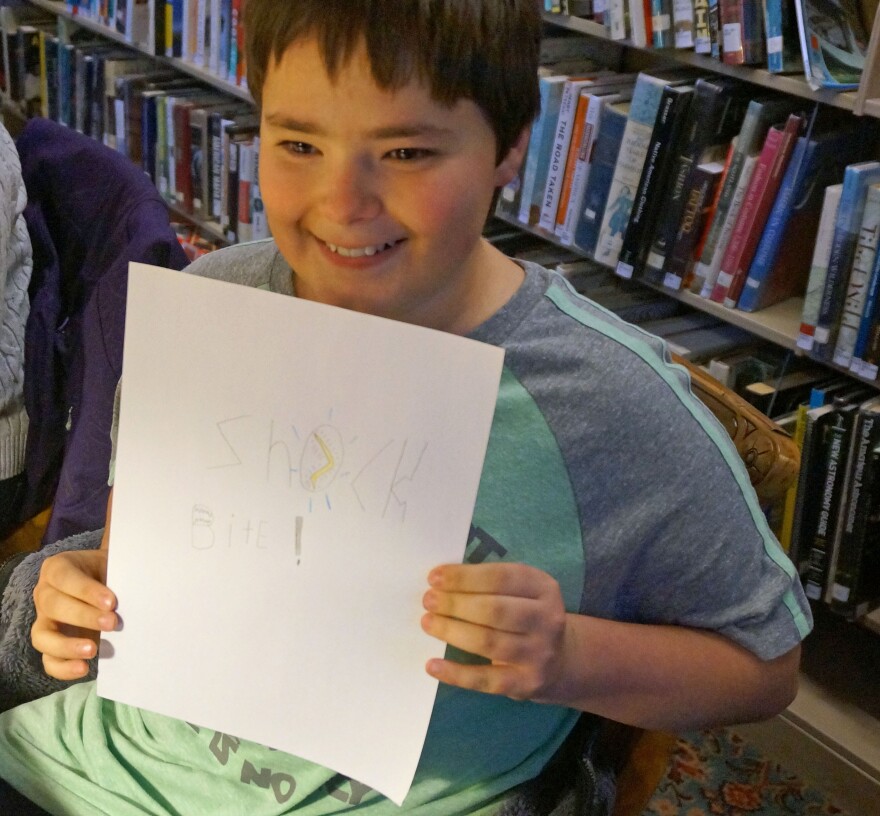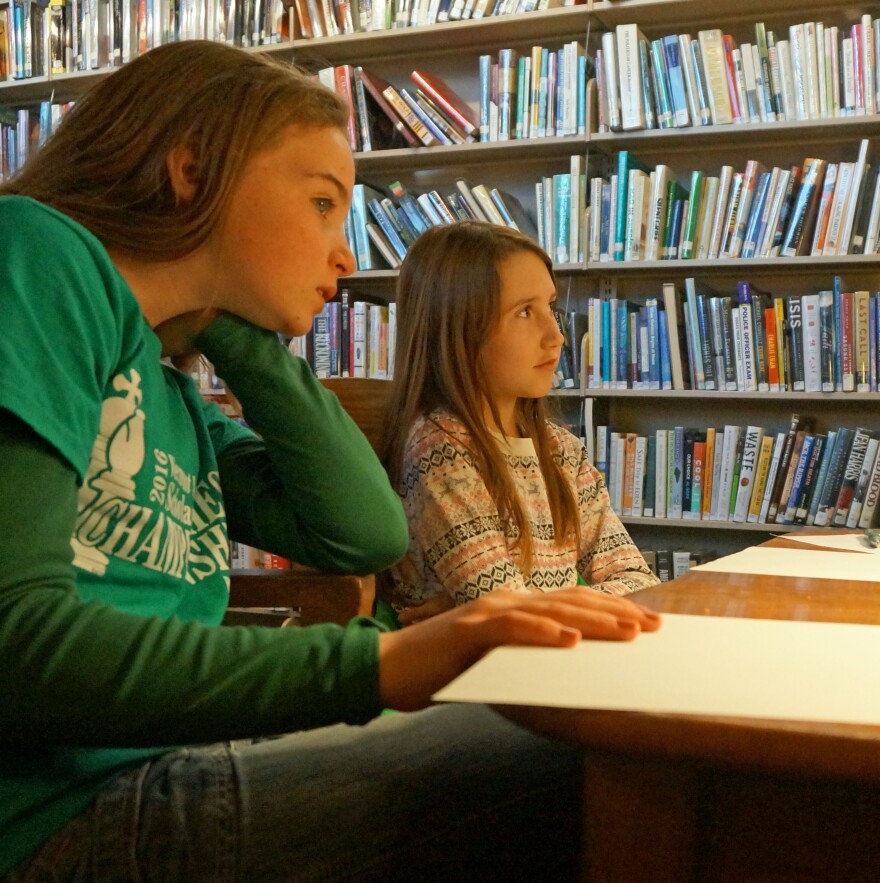If books are supposed to open up new worlds to readers, then Victoria Jamieson's graphic novel Roller Girl has hit its mark with a group of young readers at the St. Johnsbury Athenaeum.
An oversized video monitor sits at the Athenaeum, blaring rock music. On the screen, muscled women in short-shorts, fishnet stockings and roller skates are knocking each other down.
Adele West-Fisher is the youth services librarian at the St. Johnsbury Athenaeum. She admits this isn't a typical activity for her group of readers amid the tall, arched windows and wood-paneled walls of the historic library.
But the sport of roller derby that's being displayed on the screen is central to the book these readers have gathered to discuss.
In Jamieson's Roller Girl, the lead character Astrid spends a summer at roller derby camp. Astrid thought her best friend Nicole would be there with her, but Nicole goes to dance camp instead. That leaves Astrid on her own to find her place at the roller rink.
As Nicole spends more time with her dance friends, Astrid faces the possibility that she may also be on her own when they start middle school in the fall.
This group of readers in St. Johnsbury thought up some questions for Jamieson – who both authored and illustrated Roller Girl – and Dorothy's List put them to her.
Julia Spence: Is this based on real life? Like, is this a real story?
Victoria Jamieson: I took a lot of things from real life. One of the things I took from real life is I had a best friend named Nicole ... And when I was 12 we moved to a different state ... Nicole stayed in Pennsylvania, I moved to Florida, and it was a hard time to lose your best friend. You know, we tried to stay friends, but eventually we just started to grow apart. So that part was true to life and I wanted to put that – how much it hurts when you lose your best friend – into the book.

Gabby Anzalone: When did you get the first inspiration to write Roller Girl?
Victoria Jamieson: I started playing roller derby quite a few years ago, back in 2008. And as soon as I started playing roller derby, I knew eventually I wanted to write a book about it. I wasn’t exactly sure which kind of book I wanted to write. Most of my books before Roller Girl were for younger kids – they were picture books. And I knew roller derby was a little bit older and I wanted to write for slightly older kids. So I didn't really decide to write Roller Girl until I read the book Smile by Raina Telgemeier. And those two things together – my playing roller derby and reading Smile – it clicked for me that a graphic novel was the perfect way to tell the story I wanted to tell.

Josie Sestito: Why did you write it as a graphic novel instead of a regular book?
Victoria Jamieson: I decided to write Roller Girl as a graphic novel because I've always felt more comfortable with illustrations, rather than writing. I went to art school and I love to draw. I've always loved to draw, ever since I was a kid. And when I write a book, I tend to think in pictures first.
Ethan Spence: How did you do the art? Did you do it on a computer? Did you draw it? Did you sketch it first?
Victoria Jamieson: When I visit schools across the country, I love to talk to kids about how I make the artwork because you really don't need anything special at all. I do my first sketches in a spiral notebook that I buy at the drugstore for 99 cents, and a pencil. That's really all you need to make your own graphic novels – paper and a pencil. So that's how I do the first drafts. And when I do the final art, I just upgrade to paper and a pen and that's how I draw it. I do add the color on a computer and the words on a computer. But you definitely don't need those tools to make your own graphic novels.

In roller derby, players don't only have wild makeup, tattoos and hair color. They also go by creative roller derby names. And Jamieson says she had a good time researching names for her book.
Victoria Jamieson: That was a really fun part of writing the book, because there are 16 girls on her team that all needed roller derby names. And it's hard to come up with roller derby names. So I actually wrote to junior teams around the world, so there are skaters from Canada, Australia, Sweden, England ... Just all over the world and all over the United States. And I wrote to junior teams – kids as young as 7 or 6 can play junior derby – and I asked if any of them wanted to have their names in the book. So kids would send in their names and their pictures, and that was a really fun part of writing the book.
And as for her own name …
Victoria Jamieson: My roller derby name is Winnie The Pow. I wanted to have a name that connected with children's literature and a lot of the good ones like Hermione Danger, or like Pippi Strongstocking, were taken already. So I went with Winnie The Pow.

Fun roller derby monikers aren't the only names in the book. Part of the story shows Astrid getting bullied in elementary school.
Logan McGregor: When you gave Astrid the rude nickname that the kids that picked on her gave her, why was it inspired by a bad word? And I didn't necessarily like it that much. I can relate to the book, a bit, because a lot of the kids in my class aren't necessarily that nice to me and it's kind of annoying and hard.
Victoria Jamieson: That's a good question. And I've received a few questions from teachers and parents about the bad word in the book, and whether it was appropriate or whether it was needed. And my own experience from middle school was that kids could be mean and kids use bad words all the time. And I guess I included it in the book to show that sometimes kids will say mean things to you, and you can't leave it out of books just like you can't leave it out of life.
And so I guess I put it in to show that Astrid ... was getting bullied, and sometimes you get called bad names. And I wanted to show that it's not the end of the world if you get called a bad name. She, I think, is able to prove herself and get stronger despite the other kids making fun of her. It’s not easy, getting made fun of, but you can get through it.
Astrid does emerge stronger. Despite being a novice skater, she sets her sights on becoming a roller derby jammer. That's sort of like a beginner football player aiming to be the quarterback.
Victoria Jamieson's roller derby league, the Rose City Rollers, in action:
Most people who play roller derby are blockers. They try to block the progress of the jammer, who gets a point for every blocker she gets past. So a jammer needs to be fast and agile, and she needs to be able to get up after being knocked down – a lot!
That's something Jamieson knows a thing or two about. There's a picture on the book jacket of Roller Girl showing her skating as a jammer with her team, the Rose City Rollers in Portland, Ore.

Ruby Mello: How long did it take for you to become a jammer in roller derby?
Victoria Jamieson: Roller derby, just like writing a graphic novel, takes a really long time to get good. So I'd say I was practicing for, maybe, two or three years. Our practice team is called Fresh Meat – that's what you join until you join a team. So I was maybe on Fresh Meat for about two or three years. And then I joined a team. And even when I was on a team, I wasn’t always a jammer for games. Sometimes I'd be thrown in at the last minute if we were winning by 100 points or something. So I never actually became a super-good jammer. And even to just to get to the point of jamming it took maybe three or four years.
Which is another life lesson in Roller Girl. Goals and friendships – if you want them badly enough – are worth working hard for. Even if you have to take some lumps along the way.






